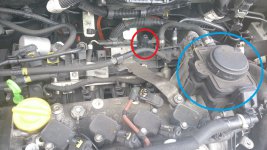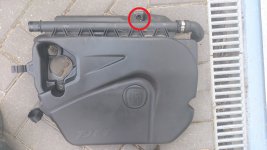Yes, the thing circled in blue is the oil separator.
On mine, all the hose clamps were easily taken off with a small flat head screwdriver.
Then remove the bolts and gently lift it up ( it has a nozzle inside the valve cover with a rubber seal on it try not to damage it)
After you've taken it off the engine work on taking the cap off ( much easier not having to bend over the engine bay); push it over the locking tabs using one or two flat head screwdrivers.
This is how you test to see if it's not working properly:
1-blow air (with your mouth...wipe first) on the nozzle that goes in to the valve cover; if it's easy to blow air through it then it's stuck open and a lot of oil will be constantly sucked into the engine. If it is to hard to blow air through or impossible then it might be stuck closed and oil will be pushed back into the cylinder past the oil rings, and the oil will be burned like that. In normal operation some pressure will accumulate until it can push a spring loaded membrane (you will see the membrane and spring when you take off the cover) and only then go into the engine.
2- Try to suck on the nozzle that goes to the intake manifold. You should not be able to suck much air because there is a flap/valve that should close when you do that ( if you can suck air in through there then that is a definite vacuum leak). Also try to blow air through that nozzle. you should not be ale to do that because another flap should block air going in that direction ( if you can blow air that way then you have a boost leak => loss in performance)
3- Blow through the nozzle that goes to the pipe before the turbo.
You should not be able to do so ( another valve). Suck through it, you should not be able to do so.
If you can suck/ blow air when i said you shouldn't that only means that the valves/flaps are stuck opened. You can clean them loose ( i did with oven cleaner and a lot of hot water)
To clean it take off the cap and thoroughly clean the membrane and spring as well as the holes/passages you will see.
Psut generous amounts of cleaner in all the hoes.. let it soak..scrub(when possible).. rinse.. repeat.
With the cap and membrane+spring taken off you should be able to :
-blow and suck air through nozzle to the valve cover
-suck air through the nozzle to the intake manifold. Not be able to blow.
-suck air through the nozzle to the pipe before the turbo. Not be able to blow.
My god, that cap was a bastard to get off.
After taking it off the engine I took the cap off and tried the tests, it failed on most. I've given it a good clean with hot water and engine de-greaser, with loads of chunks/specs of black sludge coming out. It got to a point where not much more was coming out and I stopped.
With the cap off, and clean,
- I could blow and suck through the valve cover nozzle.
- Suck through the intake nozzle, not blow,
- And suck through the turbo pipe, not blow. So passing what you mentioned at the bottom.
With the cap back on, I tried the original blow/suck tests again.
- It is still very easy to blow air through the valve cover nozzle, coming out of both the turbo and intake pipe nozzles.
- I was able to suck large amounts through the intake manifold nozzle, but not blow. I couldn't suck much at all with the valve cover nozzle blocked with my finger, and none at all with both the valve and turbo blocked.
- I am also able to suck through the turbo pipe, but not blow. Again, I couldn't suck much at all with the valve cover nozzle blocked with my finger, and none at all with both the valve and turbo blocked.
When shaking the box around, I can hear a rattle from inside. Is this normal?
I'm going to put it back in now as there is no more cleaning that can be done. Could this mean that the part is broken?




